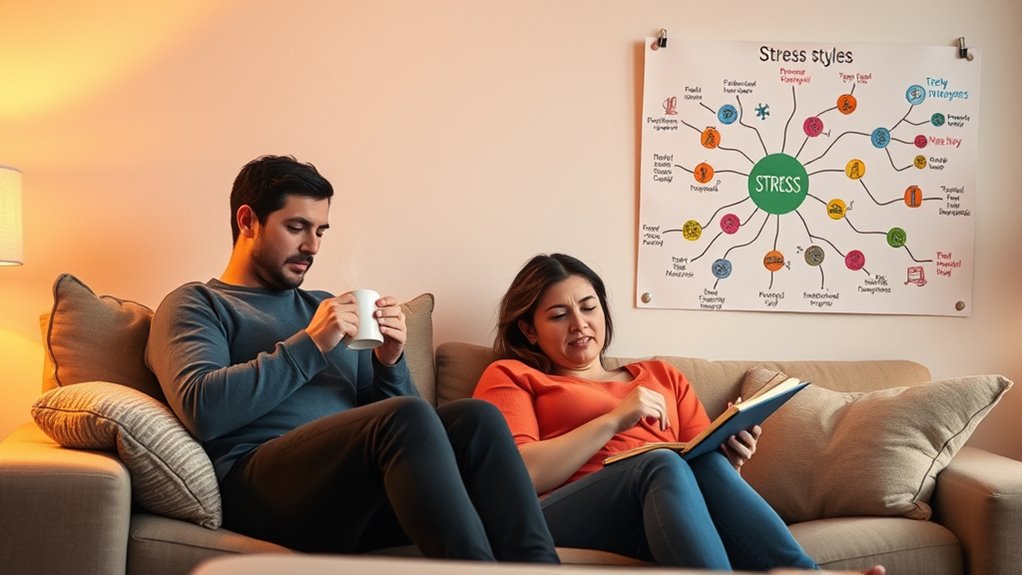When your partner’s stress style clashes with yours, misunderstandings can surface and cause emotional distance. Recognizing that their reactions are about processing stress, not rejection, helps you respond with empathy. Communicating openly and respecting each other’s needs prevents breakdowns. Focus on shared understanding and patience, turning differences into growth opportunities. By creating a coping map tailored to both styles, you can strengthen your connection—if you keep exploring how to navigate these stress responses, you’ll find even more ways to build resilience together.
Key Takeaways
- Recognize that differing stress responses are about coping, not personal rejection, to foster understanding.
- Communicate openly during stress to express needs and set boundaries without blame.
- Validate each other’s stress styles and practice patience to build mutual resilience.
- Create a safe, non-judgmental space for sharing feelings and clarifying misunderstandings.
- Use awareness of emotional cues and coping patterns to turn differences into opportunities for growth.

Stress affects couples in different ways, shaping how they handle challenges and communicate during tough times. When your partner’s stress style doesn’t match yours, it can lead to communication breakdowns and emotional misalignments that strain your relationship. For example, if you tend to withdraw when overwhelmed, but your partner seeks reassurance and closeness, these contrasting responses can create misunderstandings. You might feel frustrated because you’re not meeting their need for connection, while they might feel rejected or ignored. These mismatched reactions can deepen emotional gaps and make it harder to navigate stress together.
Mismatch in stress responses can create misunderstandings and emotional distance in relationships.
Understanding each other’s stress responses is essential. If you’re aware that your partner tends to become more reactive or distant under pressure, you can recognize that their behavior isn’t about rejecting you but about processing their stress in a specific way. Conversely, if you tend to become more reserved or anxious, your partner might interpret your silence or worry as disengagement or indifference. Recognizing these patterns helps you both avoid jumping to conclusions and instead approach each other with empathy. This awareness reduces the risk of emotional misalignments that often stem from misunderstandings about each other’s stress responses.
To bridge these gaps, you need to develop a coping map that respects both your styles. When tensions rise, instead of losing patience or escalating conflicts, take a step back and communicate openly about what each of you needs in the moment. For example, if your partner needs space, honor that request without feeling rejected. If you need reassurance, ask for it calmly rather than withdrawing or shutting down. This proactive approach can prevent communication breakdowns, helping you stay connected even during stressful periods. Remember, effective communication isn’t just about talking; it’s about listening with curiosity and compassion.
Creating a shared understanding doesn’t happen overnight. It requires patience and ongoing effort to adjust your responses based on your partner’s cues. When you acknowledge and validate your partner’s stress style, you create a safe space where both of you can express your feelings without fear of judgment. Over time, this builds resilience, making it easier to face stress together. The key is to remain flexible, recognizing that your partner’s reactions are rooted in their unique stress style and not a reflection of your worth or the strength of your relationship. Additionally, understanding the role of color accuracy in visual perception can help you better interpret each other’s emotional cues. With awareness and compassion, you can turn these differences into opportunities for growth and deeper connection.
Frequently Asked Questions
How Can Couples Identify Their Individual Stress Styles Accurately?
To identify your stress styles accurately, start by observing your reactions to stress triggers. Notice how you cope—whether you withdraw, seek support, or become overwhelmed. Reflect on past situations and ask yourself what coping mechanisms helped or worsened your feelings. Journaling or taking self-assessments can also reveal patterns. Recognizing these behaviors helps you understand your stress style and prepares you to communicate effectively with your partner.
What Are Common Misunderstandings About Different Stress Responses in Relationships?
It’s ironic how many believe stress responses are straightforward, yet emotional misinterpretations run rampant. People often fall into response stereotypes, assuming their partner’s reactions mean they’re distant or uncaring. These misunderstandings obscure the real issues, making it seem like conflict is personal rather than a natural stress response. Recognize that different styles aren’t adversaries—they’re signals to better understand, not judge, each other’s unique ways of coping.
How Do Cultural Backgrounds Influence Stress Styles in Couples?
Cultural backgrounds shape how you perceive and handle stress through cultural norms and stress perceptions. You might find that in some cultures, emotional restraint is valued, leading you to suppress stress, while others encourage open expression, making it easier to share. Understanding these cultural influences helps you recognize why your partner reacts differently to stress and fosters empathy, improving communication and connection in your relationship.
Can Stress Styles Change Over Time or With Therapy?
You might wonder if stress styles can change over time or through therapy. The answer is yes; with consistent stress adaptation efforts and the right therapy impact, you can develop healthier coping mechanisms. Therapy helps you understand and modify your responses, leading to more balanced stress management. Over time, these changes can improve your emotional resilience and your relationship, making stress feel less overwhelming and more manageable.
What Role Does Communication Play in Managing Mismatched Stress Responses?
Did you know that effective communication can reduce relationship stress by up to 50%? When managing mismatched stress responses, your role is essential. Use emotional language to express your feelings honestly, and practice active listening to truly understand your partner’s perspective. This openness fosters empathy, minimizes misunderstandings, and strengthens your connection, making it easier to navigate stress together. Clear, compassionate communication is your best tool for harmony.
Conclusion
So, the next time you notice your partner’s stress style clashing with yours, remember it’s no coincidence—they’re just trying to navigate life’s ups and downs like you. Embrace those moments as chances to learn and grow together, turning conflict into connection. When you both understand each other’s coping maps, you’ll find that even the biggest stressors become easier to handle—almost as if the universe conspired to bring you closer, not apart.









